Did you know that 70% of customers prefer to use a company’s website to get answers to their questions rather than use phone or email?
A customer service knowledge base can enable this by providing easy access to information 24/7.
A Customer Service Knowledge Base addresses challenges like reducing the volume of repetitive inquiries, improving response times, and enhancing overall customer satisfaction.
In this blog, we will discuss the best practices for creating and maintaining a customer knowledge base, provide real-life examples of successful implementations, and explore the top five knowledge base software that can help you get started quickly.
What Is a Customer Service Knowledge Base?
A customer service knowledge base is a self-service platform containing detailed knowledge base articles, how-to guides, video tutorials, and other helpful information that customers can use to troubleshoot problems on their own.
It comprises a rich combination of written text and powerful visuals to give customers an engaging learning and problem-solving experience.
The aim is to assist customers throughout their journey with your brand and keep them away from the cumbersome process of shooting emails and calls for trivial issues.
Why Do You Need a Customer Service Knowledge Base?
As a business that keeps customers front and center, you should know that customers really want quick, quality support with the least effort. And there is only one thing that meets all these quality, speed, and convenience requirements: a customer self-service knowledge base.
In fact, self-service is currently preferred the most by customers when they need help. Research reveals that 81% of customers today attempt problem-solving on their own before contacting a live company representative.
You can easily meet customer expectations for fast and quality support by deploying a customer-facing knowledge base. As a 24×7 accessible resource, customers can get their questions answered anytime and from anywhere they want.
This sheer convenience of finding help right when needed increases retention, builds trust, and improves customer satisfaction.
What Are the Benefits of a Customer Service Knowledge Base?
A customer knowledge base can bring you more benefits than you could ever imagine. For customers, it’s a self-help resource, and for agents, it gives them respite from repetitive questions.
Dive in to learn about the importance of a customer service knowledge base and its benefits.
Deliver 24×7 Support
A knowledge base empowers customers to get instant answers to any questions they have. As a 24×7 operational resource, customers can get help anytime they need it.
Unlike traditional support channels like phones and emails, a knowledge base functions round-the-clock, enabling customers to solve problems on the spot. With no barriers of time and place, you can serve a diverse customer base spread across the globe at a minimal cost.
Improve the Efficiency of Your Support Team
Productivity takes a hit when tickets are endlessly streaming from all directions. Things get worse when the timelines are short!
A self-service help center reduces the ticket volume, allowing support executives more space and time to work on complex customer problems requiring more focus and involvement.
Besides, it saves agents from scrambling for information in scattered documents while the customer waits for a response.
Your support team can instantly access the internal customer support knowledge base for product details and troubleshooting tips and provide quick resolutions to problems.
| Related blog: Reduce Support Tickets With Self-Service Knowledge Base |
Increase Online Traffic & Visibility
With a search engine-optimized knowledge base, your customers and prospects will be able to reach you faster.
Every time customers search for a query on Google, they are likely to stumble upon your customer knowledge base. This is a possibility, especially when your knowledge base is optimized well with the right keywords and top-notch content that’s relevant and up-to-date.
As Google starts identifying your knowledge base as a valuable resource that’s helping millions of customers, traffic, visibility, and ranking are bound to improve. This will also positively reflect on your brand, and people will start seeing you as the industry expert they can rely on.
Reduce Customer Service Cost
It’s surprising how much money can knowledge base can save businesses. Providing customer service through a knowledge base is the best way to keep your support costs under check.
It allows you to cater to a large customer base spread across the globe without increasing your support costs. And even if your customers increase, you don’t need to add more support reps to your team.
Also, with a self-service knowledge base, your ticket volume will reduce gradually, which means your small support team will be sufficient.
| Related blog: Things You Should Know About a Support Knowledge Base |
How to Create a Customer Service Knowledge Base?
Building a knowledge base for customer support involves using your research, writing, and design skills in the best possible way. The following steps will get you started right away:
1. Decide the Topics to Cover
Deciding which topics to add to your knowledge base is a real challenge. Your chosen topics should be carefully thought out to help customers solve real problems.
Consult with the people who regularly deal with customers, such as the sales and support team. Even your marketing team can provide valuable insights into customers’ changing needs and preferences.
Ask your support staff about the frequent challenges customers encounter and the pain points that bother them the most. Go through the social media inquiries raised by customers, identify the critical ones, and ensure you cover them in your knowledge base.
2. Work on the Design & Structure
Structuring the knowledge base is essential for an exemplary user experience regardless of how many articles you have. Keep the structure simple and clean so customers can navigate to their desired topic quickly. Create broad collections or categories where you can place all topics systematically. These categories will be different for different businesses.
For example, a SaaS company will have categories like – “Getting started with the product,” “How to use the product,” etc., and a travel company will have sections on – “Flight Cancellations,” “Flight Booking Issues,” “Refunds,” etc.
Second, a standard architecture for all articles must be created. The articles should start with the essential or most critical information – like an introduction to the topic. Then, they should jump on to the detailed, how-to sections and have a closure with other action items at the end.
3. Establish the Writing Process
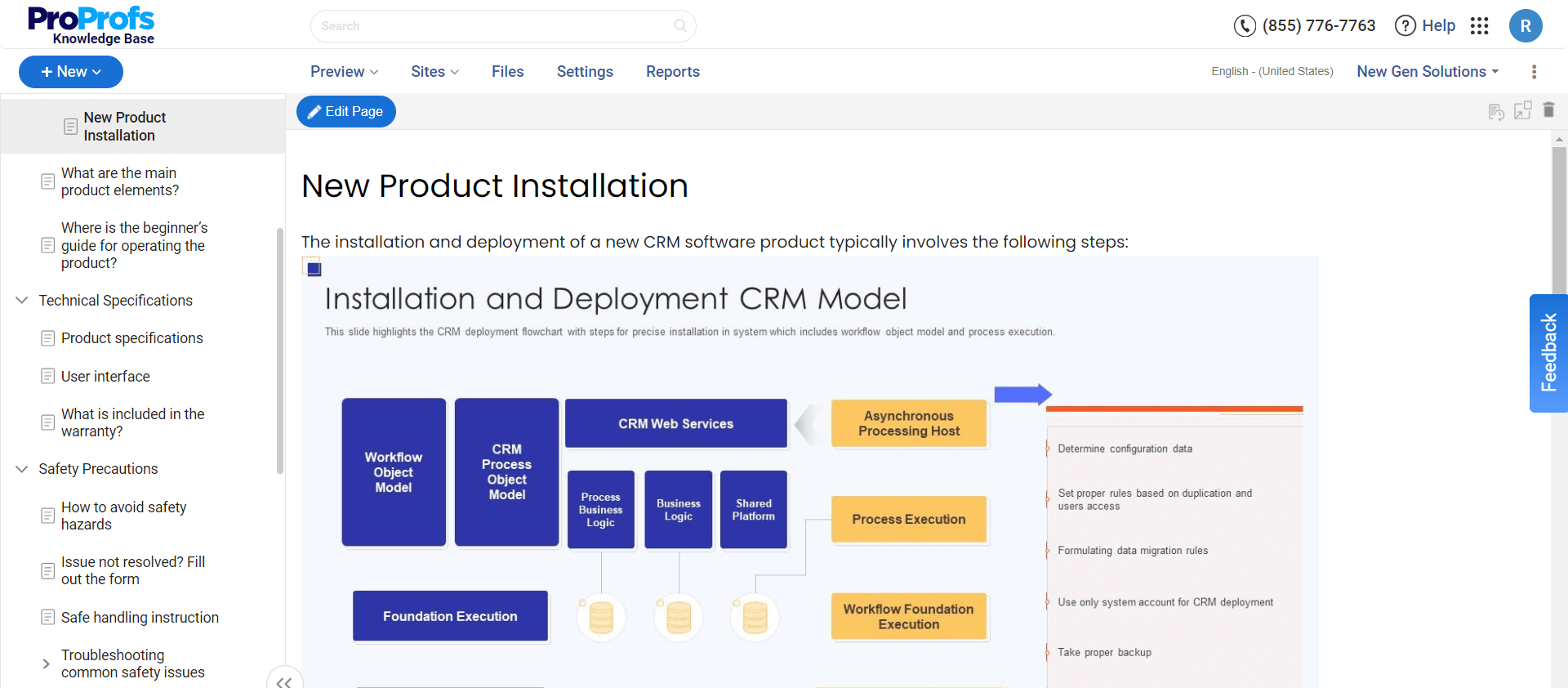
You need a standardized process to ensure content is written in a particular format across your knowledge base. With writers and editors following a defined format and style, there will be little room for inconsistencies and errors.
This will also help your team create content that reflects your brand’s voice and speaks directly to customers.
Here are a few practical guidelines that should be followed when writing content for your knowledge base for customer support:
- Keep the paragraphs short and straightforward
- Avoid beating around the bush
- Keep the titles short and action-oriented
- Use bullet points as they are easy to follow
- Provide readers with some breathing space between paragraphs
- Use fonts and colors that go well with your brand
- Interlink related articles to make navigation effortless.
4. Establish Team Roles for Content Creation
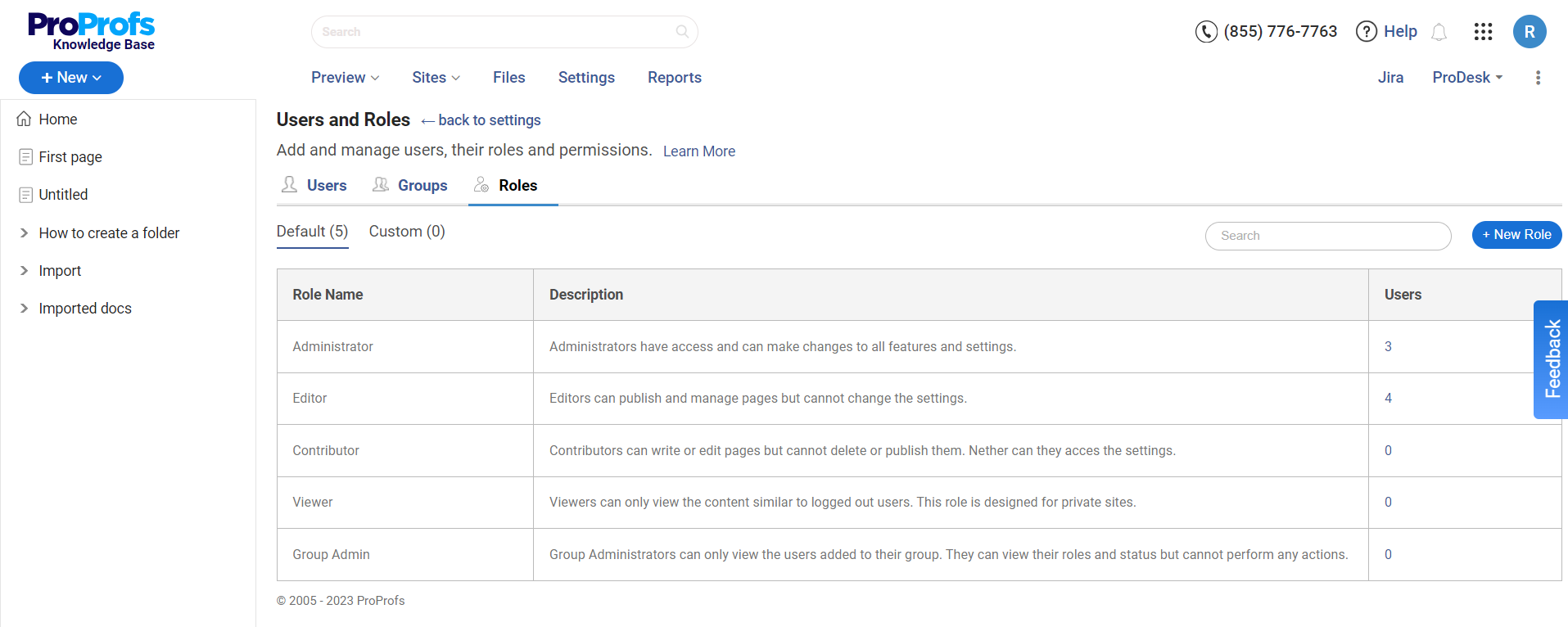
Ask experts across departments to work cohesively as one big, unified team to build and manage the knowledge base. When a team works dedicatedly, there will be fewer errors and better content quality. Allow them to bring their skills and unique knowledge to the table and work on different areas—writing, editing, and managing—to build a stellar customer service knowledge base.
For example, key members of your support team can write articles on common customer issues, and those from the product team can check the accuracy of the product-related information. Writers can create content from scratch, while editors can edit them for clarity.
You can also assign project managers to oversee the entire process and address any challenges. Working collaboratively towards a common goal will help expedite the process and bring impeccable results.
5. Review the Document
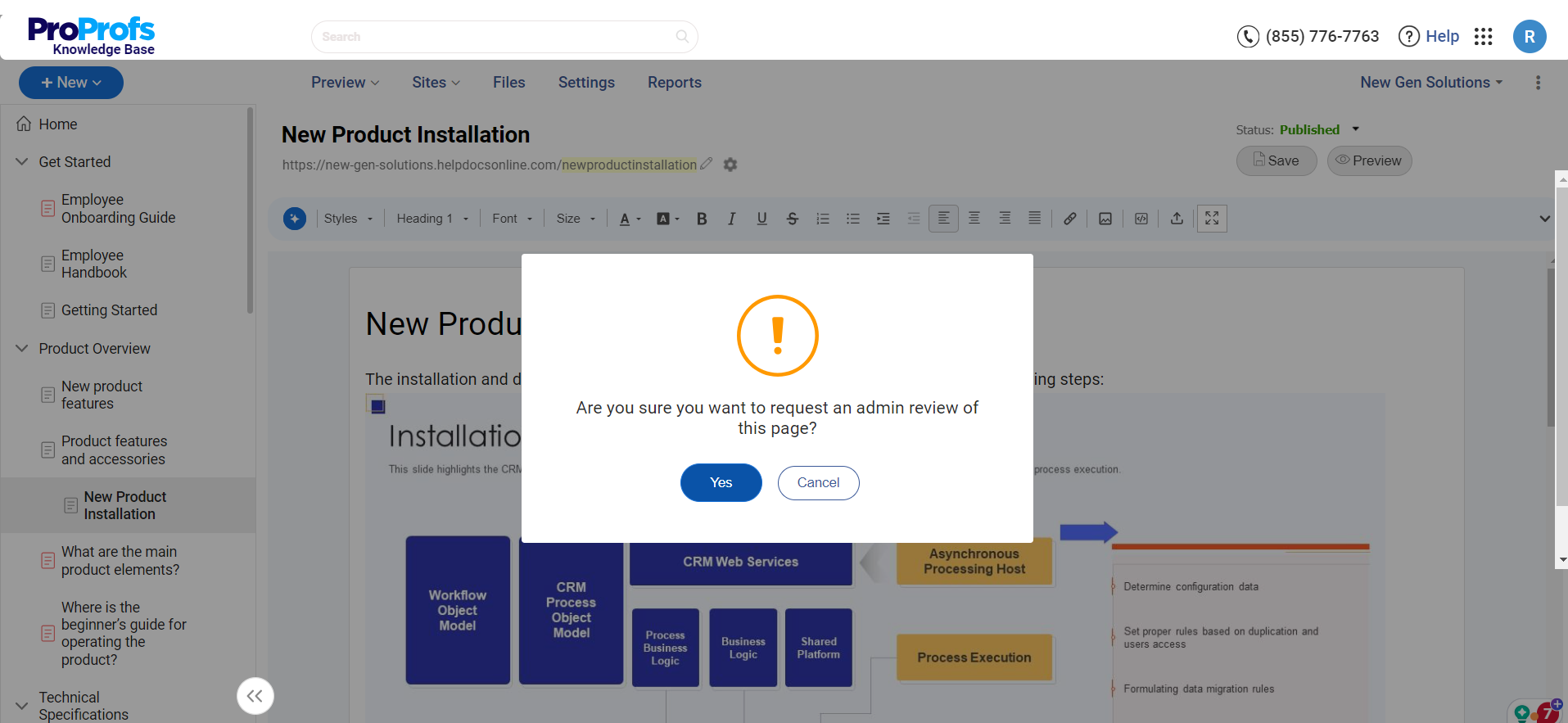
Another critical step in the process is content review. A transparent review and approval system allows writers to set a status for each article and monitor it until it is approved and published.
Some of the best knowledge base software offers pre-defined statuses such as – In Progress and Ready for Review”. You can also create a unique custom status matching the current stage of the article.
Assigning statuses to articles informs everyone about where an article is stuck in the process, what’s pending review, and what’s good to go. Such transparency is indispensable for the review process to deliver efficient results.
6. Gather Customer Feedback
Most companies create a knowledge base and leave it for customers to use without realizing the need to take their feedback. Being direct users of your self-service content, the insights, suggestions, and feedback they can give you are unmatched.
Besides, asking customers for feedback is a great strategy for making them feel valued and heard. When they realize their concerns are being heard, they will be more than happy to stay with your company for a long time.
Most knowledge base tools provide built-in feedback forms and surveys that can be embedded inside every article. Right after reading an article, customers can fill out the form by answering a simple question – “Did you find the answer helpful”?
7. Track Metrics to Boost Performance
Customers often find it challenging to find the correct information that closely matches their search query, so it is essential to continuously replenish your help center with the latest information to stay fit and relevant to customers’ changing needs.
This is a common issue customers face, but most are not very vocal about it. They would instead leave the site and switch to the mediums they are more habitual with – emails and calls. Such situations call for a system prioritizing continuous monitoring and improvement of self-service content.
Tools like ProProfs Knowledge Base comprise a built-in reporting system that provides eye-opening insights into article performance, knowledge gaps, and self-service patterns.
FREE. All Features. FOREVER!
Try our Forever FREE account with all premium features!
What Are the Best Practices for Creating a Knowledge Base for Customer?
Building a self-help knowledge base is the first step toward achieving customer service excellence. Besides following the steps mentioned above, there is so much more you can do to improve the self-service experience.
Let’s explore some customer service knowledge base tips and best practices.
Use Knowledge Base Templates to Speed Up Your Work
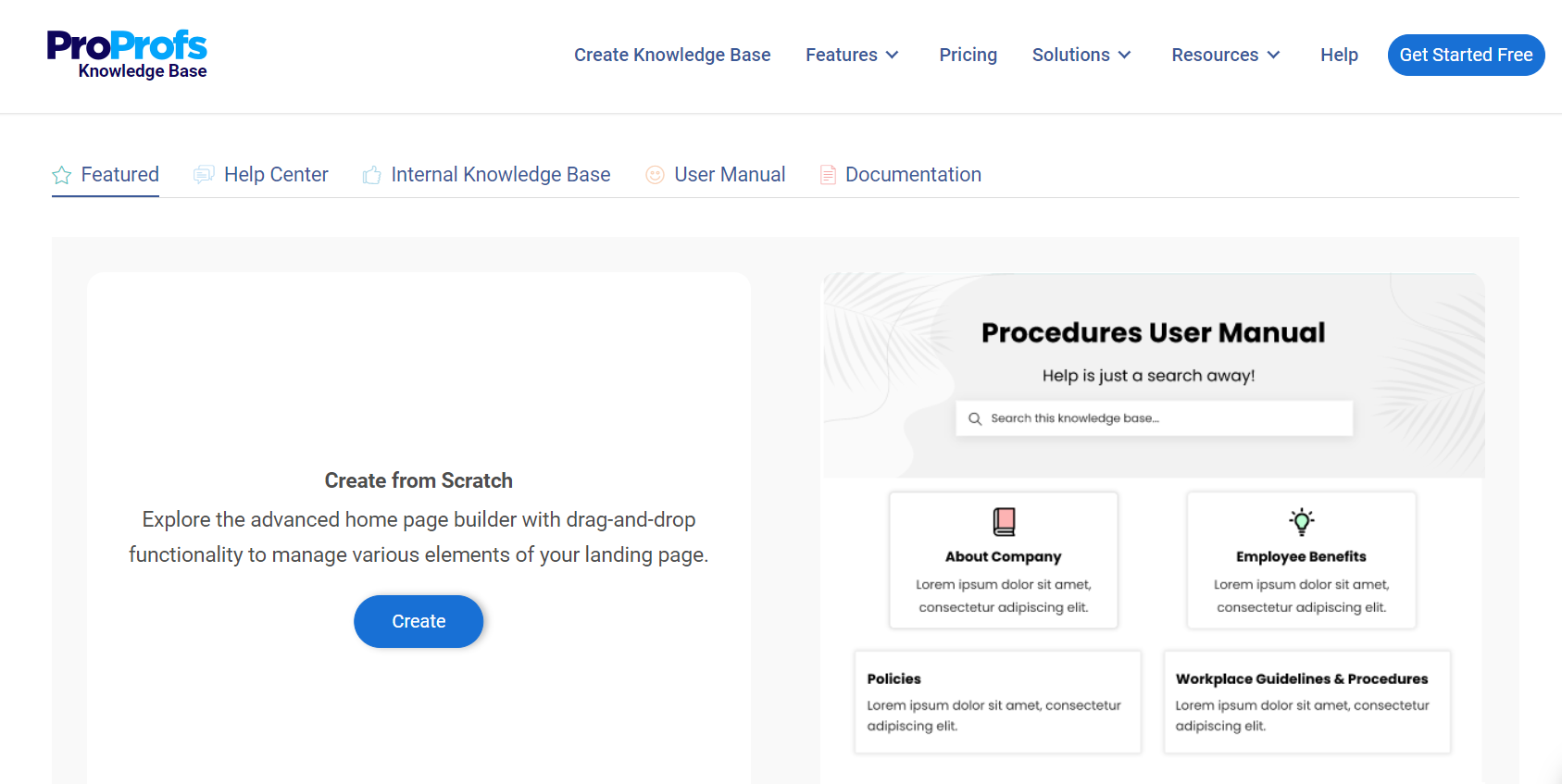
Explore 100+ Knowledge Base Templates Now
Ready-to-use knowledge base templates can give you the right headstart as you begin the journey of creating a customer service knowledge base.
Such templates have a predefined structure, including a table of contents, a space for your company name and logo, article categories, and subcategories. Since the structure is already set, you can be completely focused on creating meaningful, high-quality content.
Prioritize Content Clarity
A rule of thumb for an exemplary self-service experience is to use easy language and a clean structure to keep your content clear. The headings and sentences should be actionable and give customers a clear idea of the information they can expect to find in the article.
Avoid writing large blocks of text as they are difficult to digest. Make your content scannable by adding bullet points, highlighting key sentences, and adding the necessary white space.
A searchable knowledge base can be the best thing for your business. As you start typing the keywords, it should display relevant articles closely matching your queries. You can further improve the search experience by using the right keywords across articles, creating high-quality content, and building a structure that’s easy to navigate.
Include Visuals to Enhance Engagement
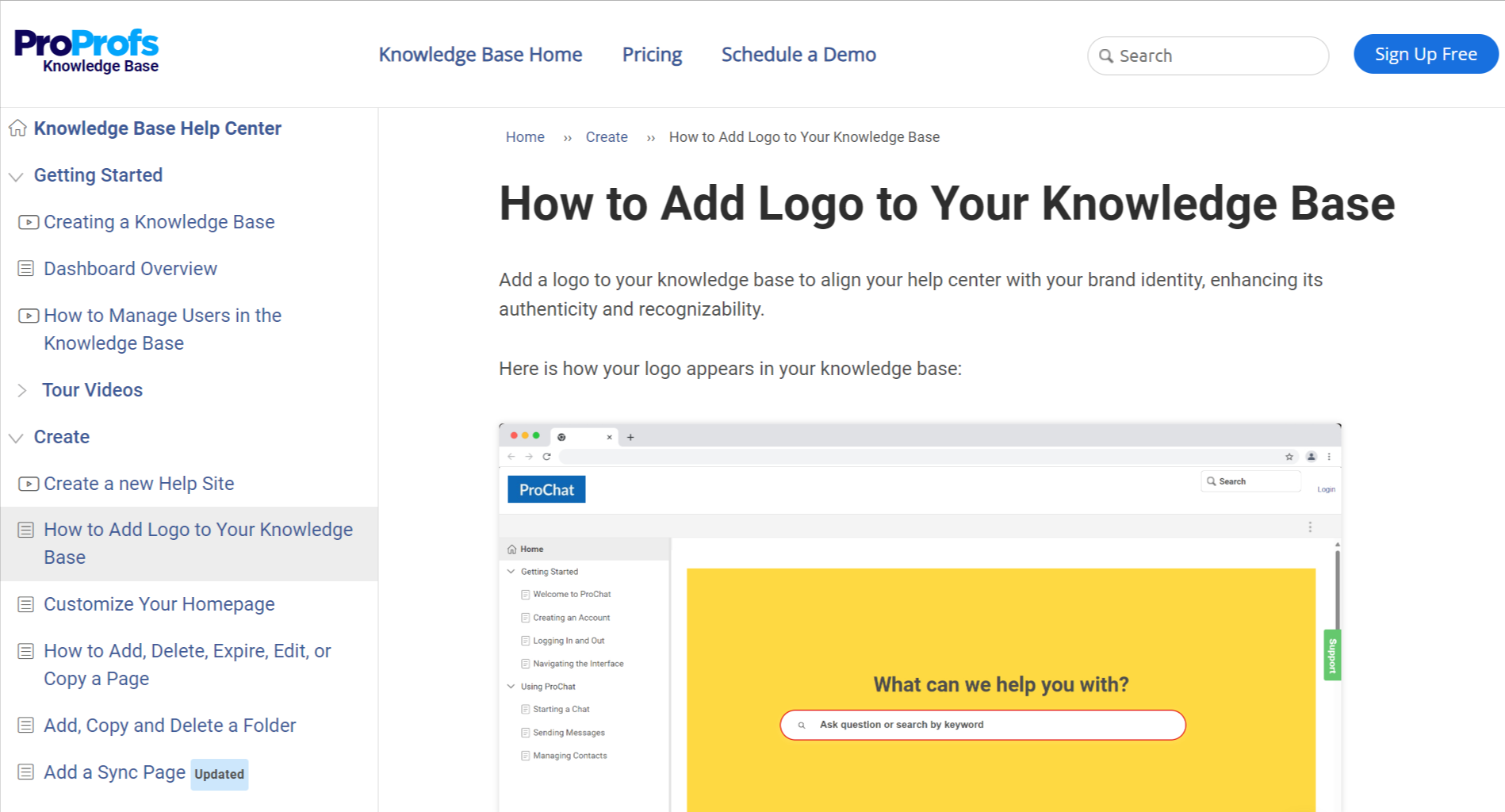
When written text is combined with relevant images and videos, it leaves a positive impact on customers. Customers can learn by reading about the processes as well as watching them in action, which makes it a fun and engaging experience.
Visuals also provide a breather from the large chunks of text. Support your knowledge base content with the right visuals and watch your customers solve problems quickly and happily.
Connect Your Knowledge Base With Help Desk & Live Chat
ProProfs Help Desk and ProProfs Live Chat —Knowledge base integration with live chat and help desk can weave magic into your support process. This combination gives customers the triple benefits of self-service, chat, and ticketing—a 360° support experience.
For example, if your knowledge base works well with your help desk, it will be easy for customers to raise tickets right from where they are. These tickets will directly reach your help desk account, from where they can be managed, prioritized, and resolved.
Similarly, by connecting knowledge base and live chat, you can add help articles to your live chat widget and delight customers with an instant self-service experience. Right from the chat window, customers will be directed to your self-service portal to self-solve queries.
Top 5 Best Customer Service Knowledge Base Software & Tools in 2024
A customer service knowledge base platform should offer intuitive navigation and powerful search capabilities to help users quickly find information.
Let’s explore five such knowledge base tools that enable the same and more.
1. ProProfs Knowledge Base – Best for Easily Creating Help Sites, Manuals & Private Knowledge Bases
ProProfs Knowledge Base’s AI-enabled WYSIWYG editor and a variety of pre-defined knowledge base templates allow teams to create customer service knowledge bases, user manuals, and FAQs efficiently. The best part is that you can choose to keep your knowledge base public, private, or embedded inside your app/software.
Users can insert images, videos, and links directly into their documents, enhancing the instructional value of the content.
It also supports real-time collaboration with features like internal comments for collaborative editing, role-based workflows for outlining member responsibilities, and conditional content for secure information sharing.
What you will like:
- Powerful search functionality with auto-suggest and advanced filters, helping users find the information they need quickly and easily
- Allows Administrators to set up roles and permissions to control who can view, edit, or manage the documentation
- Powerful analytics tools that provide insights into how the documentation is being used.
What you may not like:
- Forever Free plan is limited to 25 articles
- While a cloud version is available, there is no on-premise version.
Pricing:
Forever Free plan with all the premium features for up to 25 articles. Paid plan starts at $49/author/month.
2. Guru – Best for Connecting Company’s Collective Knowlege
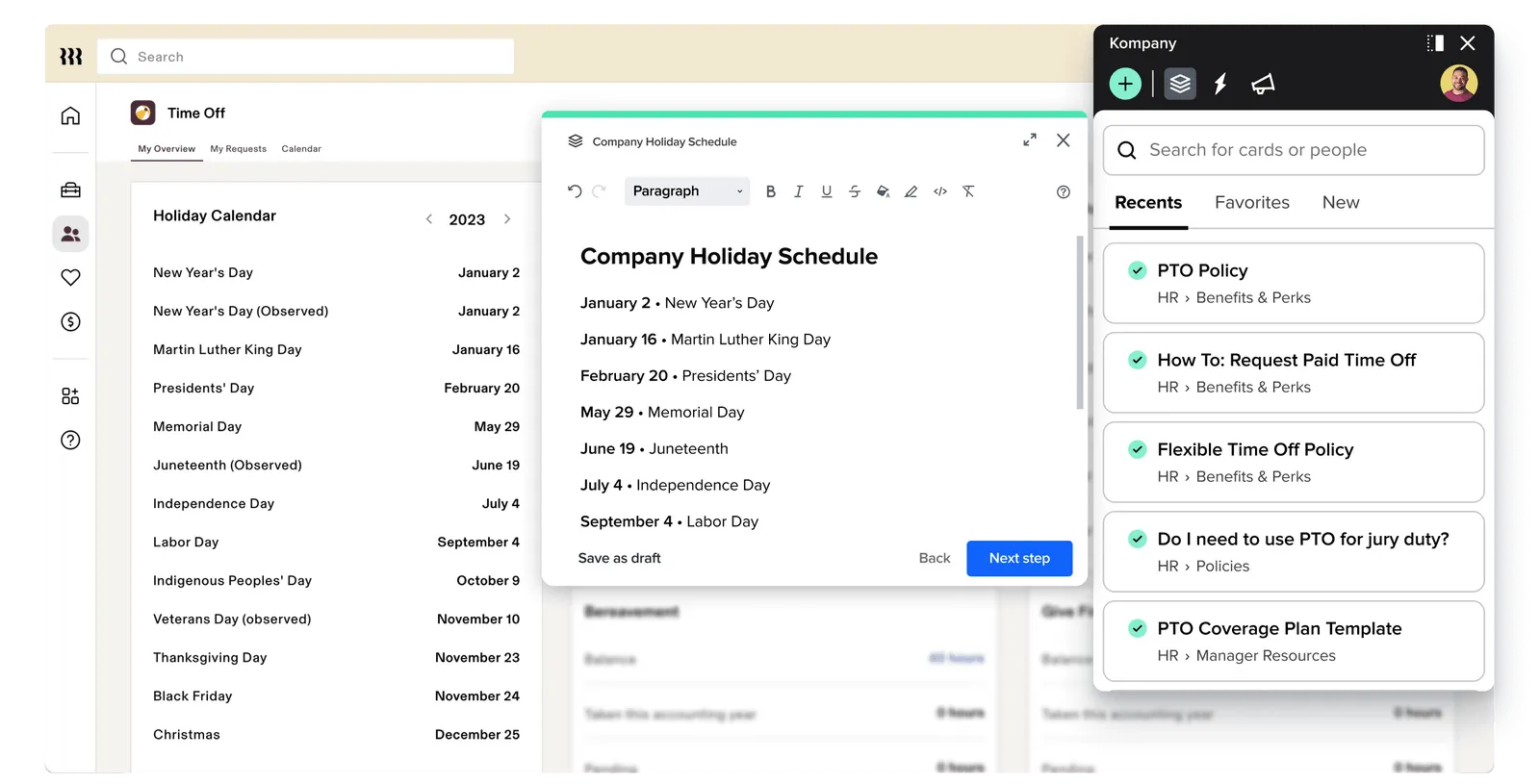
Guru’s real-time knowledge management allows teams to capture, organize, and access information seamlessly.
By integrating directly into the workflow tools that support teams already use, such as Slack, Microsoft Teams, and web browsers, Guru ensures that knowledge is readily available precisely when and where it is needed.
Guru’s verification system maintains the accuracy and relevance of the knowledge base. Knowledge experts within the organization can set verification intervals for each piece of content, ensuring all information is reviewed and updated regularly. This process helps prevent the spread of outdated or incorrect information, crucial for maintaining high-quality customer service.
What you will like:
- The ability to integrate AI-powered suggestions into the workflow
- Proactively suggest relevant knowledge base articles and resources based on the context of the conversation
- Offers robust analytics and reporting tools that provide deep insights into how the knowledge base is being used.
What you may not like:
- Sometimes, adding videos to Cards can be cumbersome
- Limited customization options for the dashboard homepage.
Pricing:
A free plan is available for 30 days. Paid plan starts from $15/user/month.
3. Document360 – Best for Creating Online Documentation
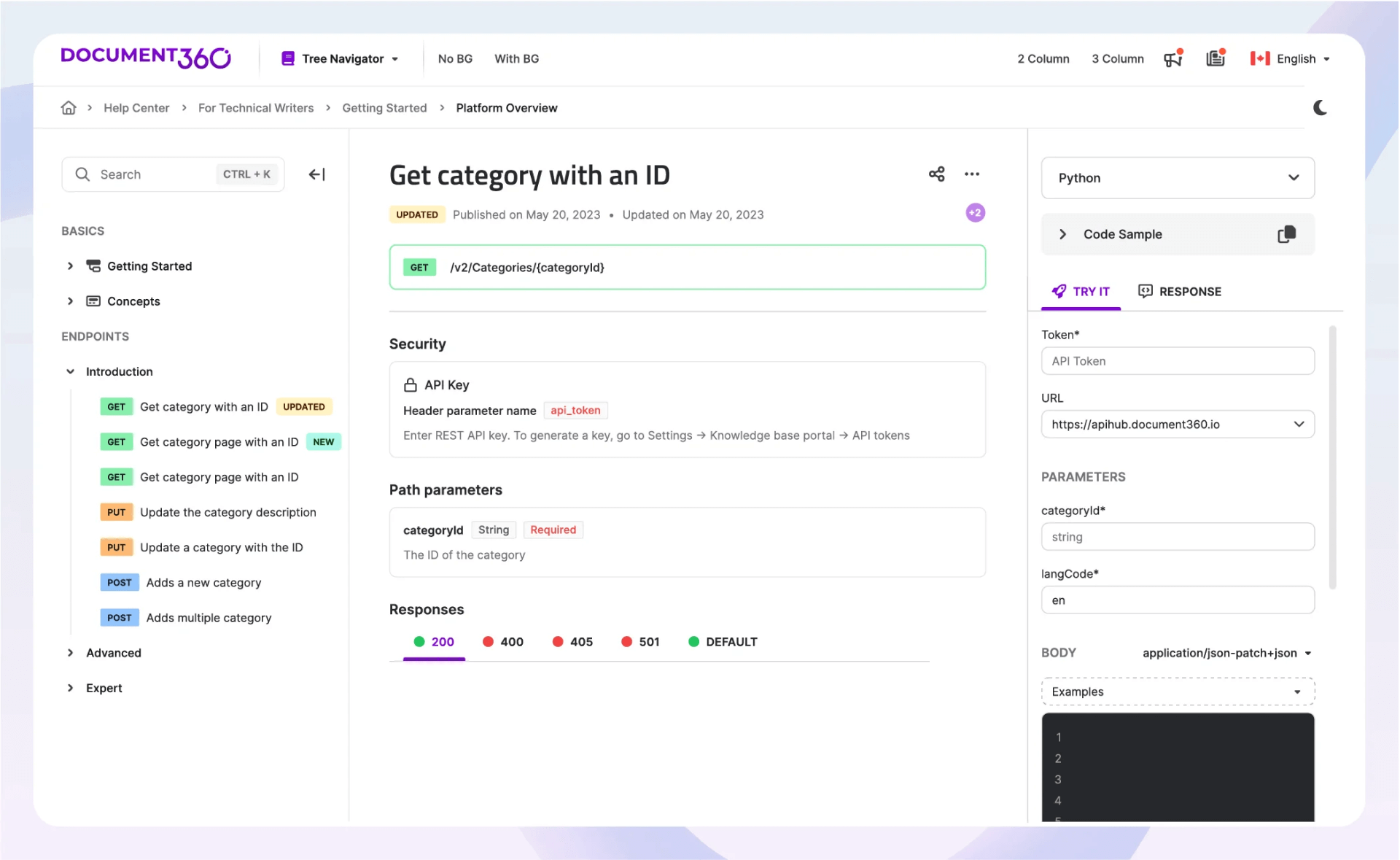
Document360’s user-friendly editor supports markdown, WYSIWYG, and HTML. This flexibility allows content creators to choose their preferred editing mode, ensuring that articles are created efficiently and effectively.
Document360 offers hierarchical categorization, which allows articles to be organized in a structured and intuitive manner. This hierarchical system makes it easy for support agents and customers to navigate the knowledge base and quickly find relevant information.
What you will like:
- Supports tagging, which further enhances searchability and ensures that related articles are easily accessible
- Enables users to track changes made to articles, revert to previous versions, and compare different versions side by side
- Give admins insights into how the knowledge base is being used, including metrics such as page views, search terms, and user feedback.
What you may not like:
- Lack of inline comments in the text editor
- Some users have reported difficulty in working with callouts.
Pricing:
A free version is available for up to 50 articles. Paid plan starts at $149/project/month.
4. Nuclino – Best for Fast Collaboration to Bring Knowledge, Docs, and Projects Together in One Place
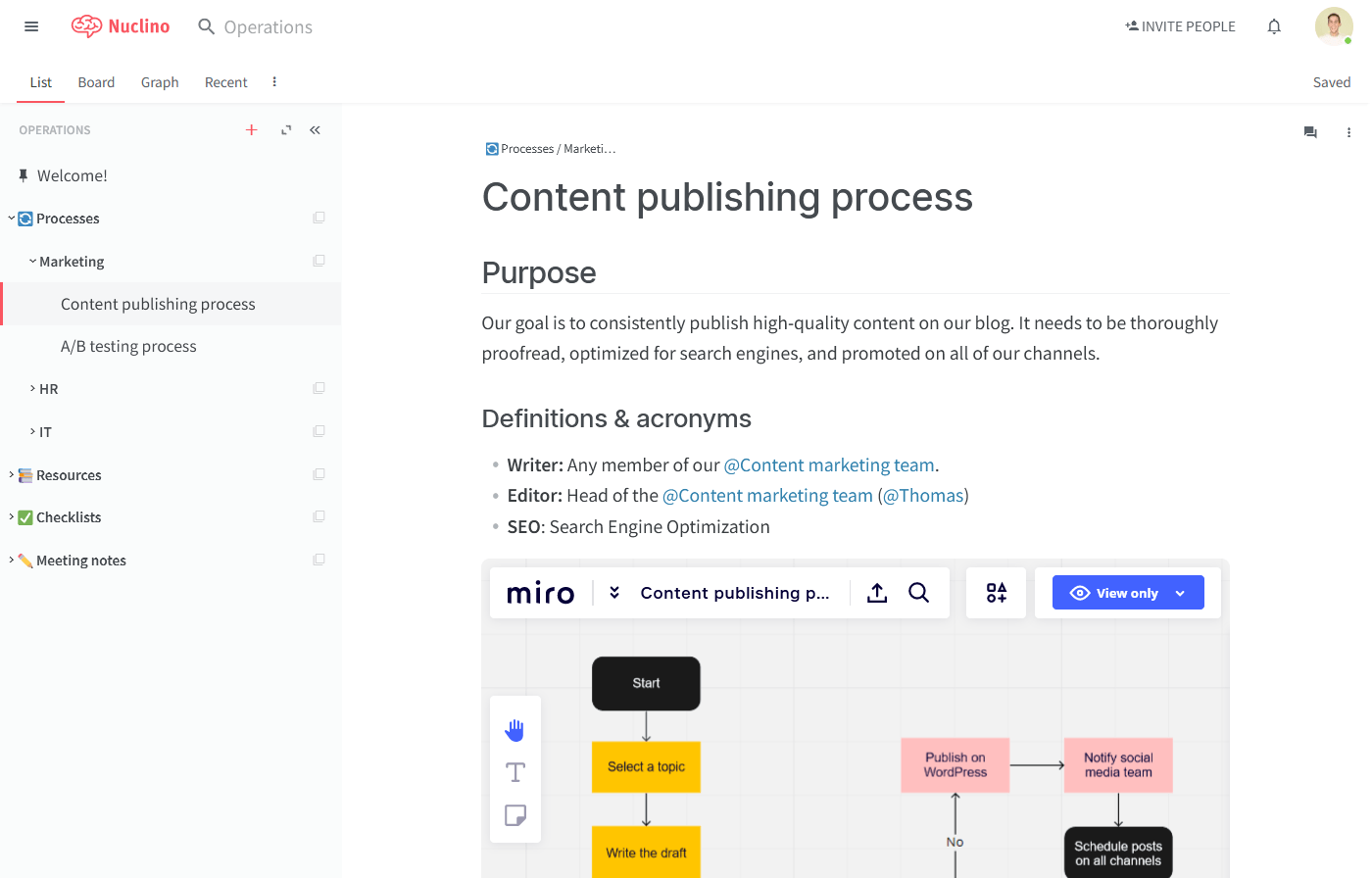
Nuclino enables a visual and interconnected structure to organize knowledge, which enhances navigation and information retrieval.
It uses a unique graph view to display the relationships between different pieces of content, making it easy to understand how various articles and documents are connected.
The platform’s search engine is designed to be fast and accurate, providing relevant results even with partial or related search terms. Nuclino also supports various content formats, including text, images, videos, and embedded files, ensuring that the knowledge base can cater to different learning preferences and needs.
What you will like:
- Rich integration with popular productivity tools such as Slack, Google Drive, and Trello
- Supports Markdown for text formatting, providing flexibility in documentation styling
- Secure access to Nuclino using SAML-based SSO.
What you may not like:
- Lack of an offline mode, which can be a problem for users needing to access documentation without an internet connection
- The customization options for the interface and workspace are limited.
Pricing:
A free plan is available. Paid plan starts at $5/user/month.
5. Confluence – Best for Team Collaboration on Documents
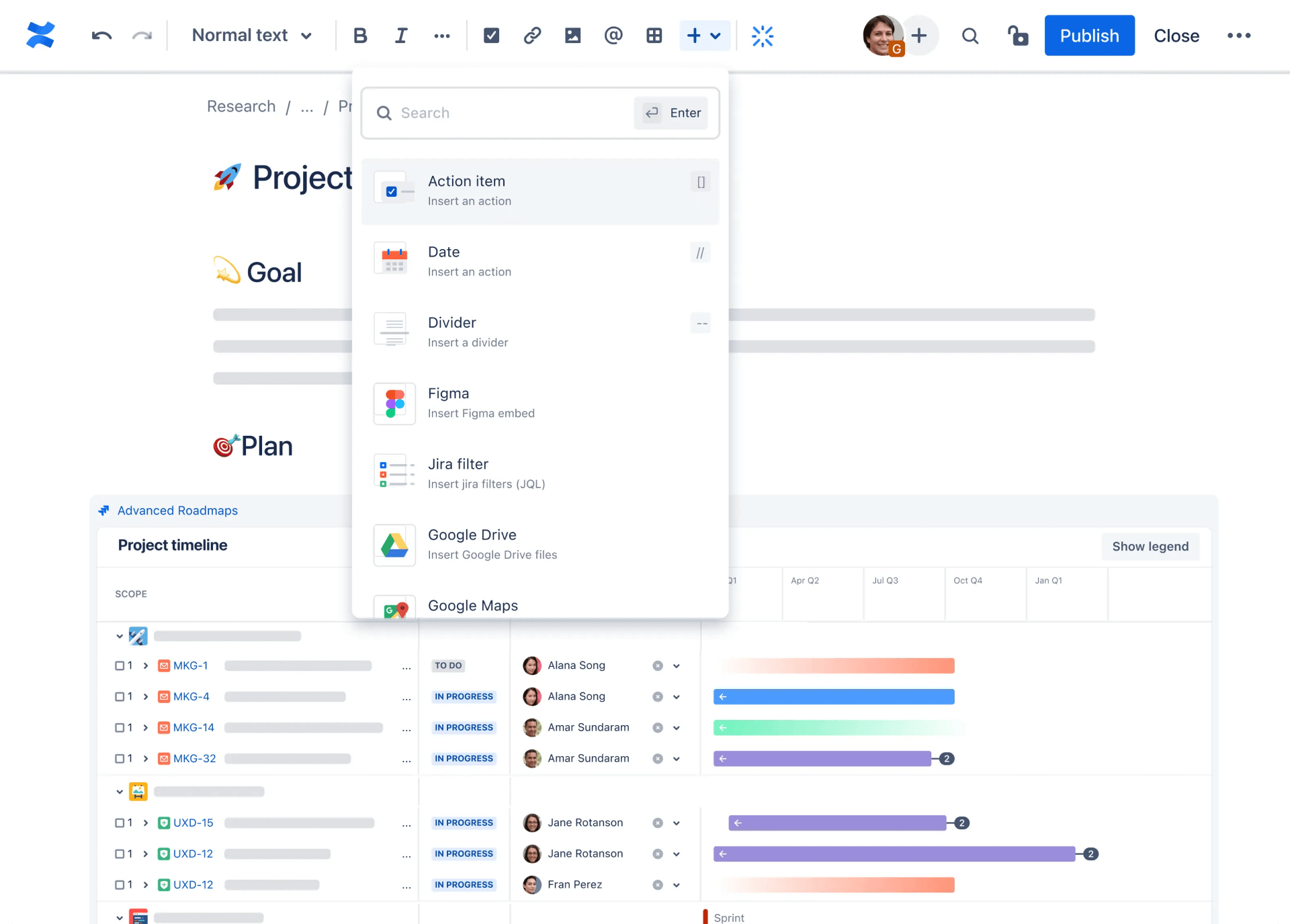
Confluence’s real-time collaboration capabilities allow multiple team members to work on the same document simultaneously, seeing changes as they happen.
It is essential for maintaining up-to-date knowledge bases, as it enables support teams to update information quickly and ensures that all members have access to the latest data.
The platform seamlessly integrates with other Atlassian products like Jira and Trello and third-party applications such as Slack, Google Drive, and Microsoft Teams. These integrations ensure that customer service teams can access the knowledge base within their primary tools, streamlining workflows and improving efficiency.
What you will like:
- Enables a powerful search engine that indexes all content, making it easy for users to find specific information quickly
- Supports customizable templates, which help standardize the documentation process
- Detailed analytics and reporting tools provide insights into how the knowledge base is used.
What you may not like:
- The grouping takes some experimentation to figure out how to group/organize a bunch of similar pages
- The search function can be inaccurate at times.
Pricing:
A free plan is available. Paid plan starts at $60.05/10 users/month.
Examples of Customer Service Knowledge Base
Here are some excellent examples of customer service help centers built by different companies.
ProProfs Knowledge Base
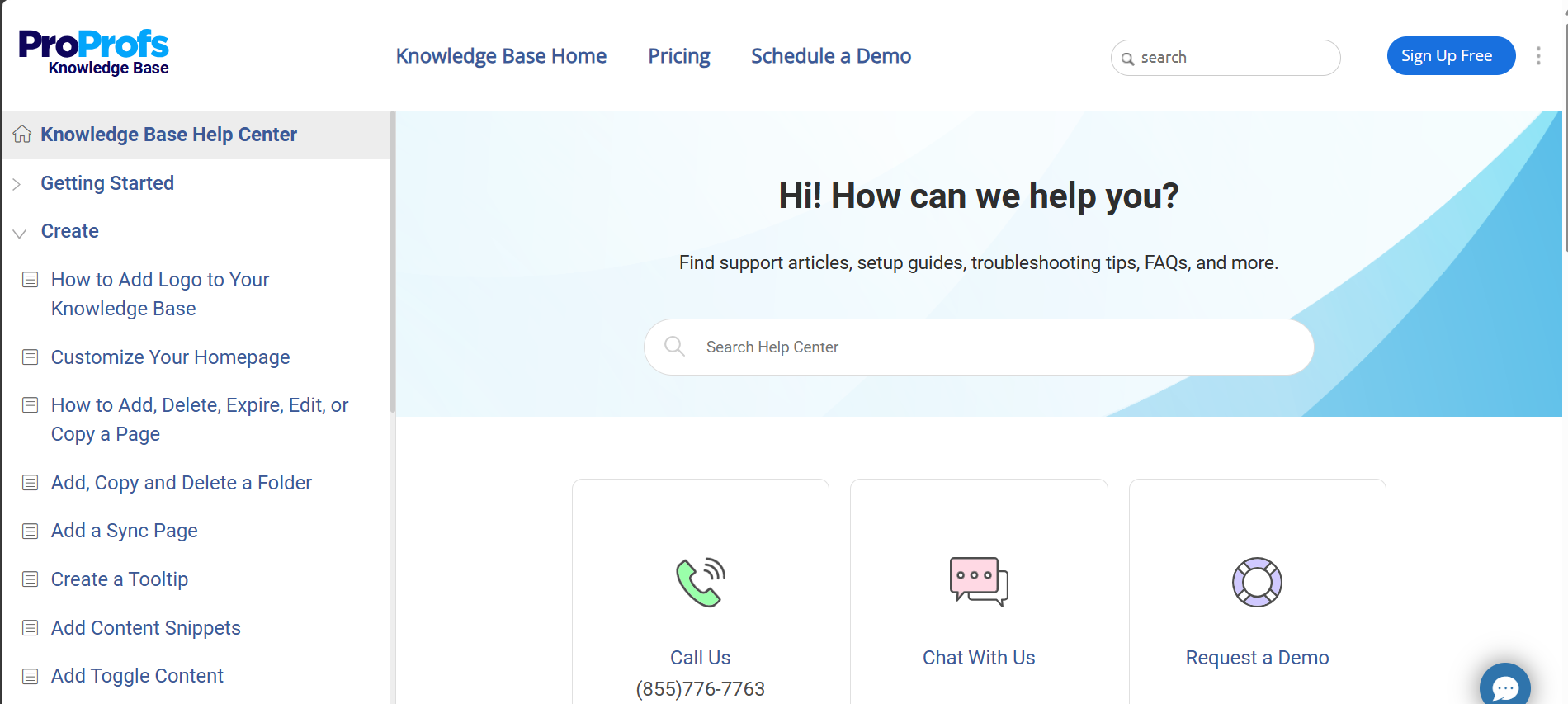
ProProfs uses a clear, concise, and user-friendly language, making it accessible to users of varying technical expertise. The format is well-structured, with step-by-step instructions, bullet points, and numbered lists, ensuring that information is easy to follow and implement.
Each section is logically organized, with headings and subheadings that seamlessly guide the reader through the process. The article incorporates relevant screenshots and icons to illustrate key steps, providing visual cues that enhance understanding.
Zoho Manage Engine
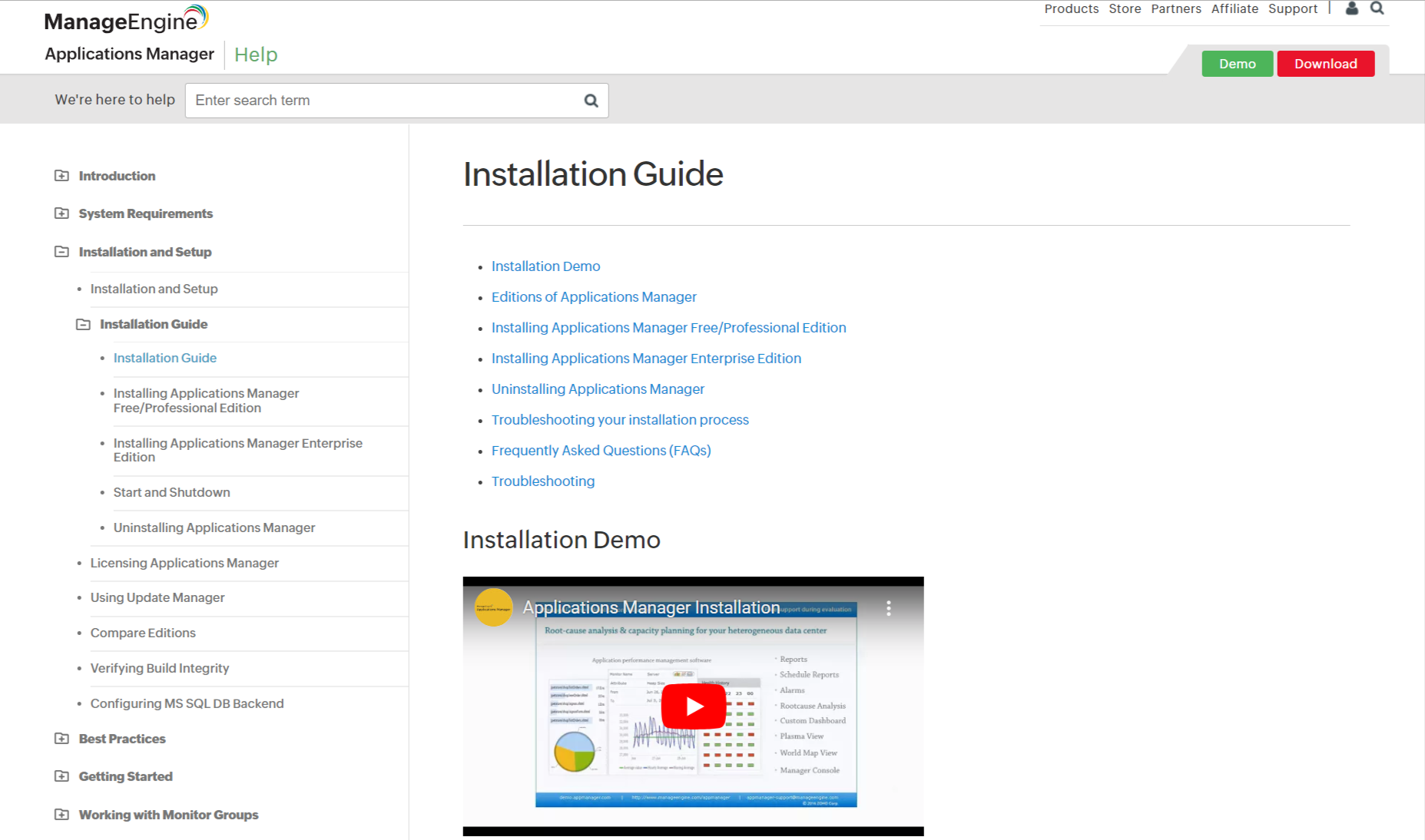
ManageEngine’s knowledge base articles are well-structured, providing clear and detailed instructions. The language used is technical yet straightforward, ensuring that the content is accessible to IT professionals while maintaining precision.
Visually, the article incorporates a description video that aligns with the text, providing visual support to the written instructions. These visuals enhance understanding by showing exactly what users should expect to see at each step of the installation process.
Apple

Apple’s support center looks simple, clean, and modern. It has a big search bar right in the middle, where customers can easily look for information.
The categories of Apple’s products are also shown right in the beginning to help customers directly land on the page they want to see. Additionally, each page has feedback, a related articles section, and the option to reach your customer support experts.
It is a simple and well-thought-out customer service knowledge base designed to provide an impeccable self-service experience.
Enable Effortless Customer Self-Service With an Insightful Knowledge Base
Building a customer service knowledge base is a cost-effective way to get attractive dividends in the long run.
When you let customers help themselves, you help your business, too! Tickets are reduced, agents’ workload is reduced, and agents have far more time to devote to challenging customer issues.
You can start the process by identifying the topics to be covered and then move on to giving your knowledge base a good structure that’s easy to scan. The content you finally publish should be completely error-free and prove helpful for customers.
If you are looking for a tool to launch your knowledge base, ProProfs Knowledge Base is the ideal solution. It’s simple, feature-rich, and offers powerful third-party integrations to give your customers an exemplary self-service experience. Explore the tool more for free here!
 Tips
Tips
We’d love to hear your tips & suggestions on this article!
FREE. All Features. FOREVER!
Try our Forever FREE account with all premium features!


 We'd love your feedback!
We'd love your feedback! Thanks for your feedback!
Thanks for your feedback!







